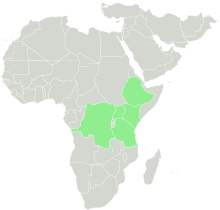Subularia monticola
Subularia monticola is one of the water loving, annuals of the genus Subularia in the family Brassicaceae. It lives in the cool, moist high elevations of Ethiopia, Kenya, Tanzania, Uganda and Zaire.[1][3]
| Subularia monticola | |
|---|---|
| Scientific classification | |
| Kingdom: | Plantae |
| Clade: | Tracheophytes |
| Clade: | Angiosperms |
| Clade: | Eudicots |
| Clade: | Rosids |
| Order: | Brassicales |
| Family: | Brassicaceae |
| Genus: | Subularia |
| Species: | S. monticola |
| Binomial name | |
| Subularia monticola | |
 | |
| Range of Subularia monticola | |
Description
Subularia monticola forms cushions or mats in moist areas in upland rainforests and moorland, such as the edges of ponds and bogs, or muddy footpaths,[1][4] though it may grow underwater in some cases.[1] It can form mats in permanently wet areas.[1] It is a short-lived plant that lacks leaves in its early development, instead having just a stem and taproot. It grows to 5 to 16 centimeters (2 to 6 inches). It produces tiny white flowers.[4]
Distribution
Subularia monticola is an African high-altitude plant, growing at altitudes of around 2,750 to 4,750 meters (9,000 to 15,600 feet) above sea-level.[1] Some examples will serve to demonstrate the range of environments in which it thrives:
On Mount Kilimanjaro, which is mostly arid, Subularia monticola grows in oases made by rain or melted snow collecting in depressions, where it forms continuous carpets of vegetation alongside Eriocaulon volkensii, Cyperaceae and Bulliarda elatinoides.[5] On Mount Kenya, cracks formed by daily freezing and thawing of ice provide a refuge for Subularia monticola seedlings.[6] It also forms short, dense mats on the occasionally flooded mudflats around Lake Kimilili, a lake 4150 meters above sea-level on the Kenya-Uganda border.[7]
References
- "Subularia monticola A.Br. ex Schweinf. record n° 78167". African Plants Database. South African National Biodiversity Institute, the Conservatoire et Jardin botaniques de la Ville de Genève and Tela Botanica. Retrieved 8 May 2008.
- Hoffmann, Matthias H. (27 October 2003). "Type specimens of the Brassicaceae in the Herbarium of the Martin-Luther-University Halle Wittenberg (HAL)". Martin-Luther-Universität. Retrieved 8 May 2008.
- K. Kubitzki; K.U. Kramer; P.S. Green; J. G. Rohwer; V. Bittrich; H. Huber; J. W. Kadereit; C. Jeffrey (2002). "Cruciferae". In K. Kubitzki; C. Bayer. (eds.). The families and genera of vascular plants. Springer Science+Business Media. ISBN 3-540-42873-9. OCLC 163376730. Retrieved 8 May 2008.
- H. Peter Linder and Berit Gehrke (2 March 2006). "Common plants of the Rwenzori, particularly the upper zones" (PDF). Institute for Systematic Botany, University of Zurich. Archived from the original (PDF) on 30 May 2008. Retrieved 6 May 2008.
- Schimper, Andreas Franz Wilhelm; William Rogers Fisher; Percy Groom; Isaac Bayley Balfour (1903). "Mountain Regions in the Tropics". In Translation of Pflanzen-geographie auf physiologischer Grundlage by William Rogers Fisher (ed.). Plant-geography Upon a Physiological Basis. Clarendon Press. Retrieved 8 May 2008.
- Mahaney, William C.; Michael G. Boyer (1988). "Notes on the Morphology and Genesis of Mud Polygons on Mount Kenya, East Africa" (PDF). Géographie Physique et Quaternaire. 42 (1): 89–96. doi:10.7202/032712ar. Retrieved 8 May 2008.
- P.A. Barker; R.A. Perrott; F.A. Street-Perrott; Y. Huang (2001). "Evolution of the carbon cycle in Lake Limilili Mt Elgon, Kenya, since 14 000 cal. yr BP: a multiproxy study". In Klaus Heine; Jürgen Runge (eds.). Proceedings of the XVth INQUA Conference, Durban, South Africa, 3–11 August 1999. Taylor & Francis. p. 90. ISBN 90-5809-350-6. OCLC 183120063.
External links
- Porter, Noah, ed. (1913). "Webster's entry needed". Webster's Dictionary. Springfield, Massachusetts: C. & G. Merriam Co.
- Meyer, Hans; E. H. S. Calder (1891). "Appendix". Across East African Glaciers: An Account of the First Ascent of Kilimanjaro. G. Philip & son. Retrieved 8 May 2008.